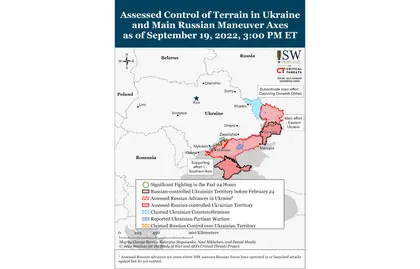Key Takeaways
- Urgent discussion on September 19 among Russia’s proxies of the need for Russia to immediately annex Luhansk and Donetsk oblasts (much of the latter of which are not under Russian control) suggests that Ukraine’s ongoing northern counter-offensive is panicking proxy forces and some Kremlin decision-makers.
- Ukrainian counter-offensive successes are degrading morale among Russian units that were regarded as elite prior to the invasion of Ukraine.
- Ukrainian forces are likely continuing limited and localized offensive operations across the Oskil River and along the Lyman-Yampil-Bilohorivka line.
- Russian forces continued ground attacks south of Bakhmut.
- Ukrainian forces are continuing to strike Russian military, transportation, and logistics assets in Kherson Oblast.
- Ukrainian and Russian sources identified three areas of kinetic activity on September 19: northwest of Kherson City, near the Ukrainian bridgehead over the Inhulets River, and in northern Kherson Oblast near Olhine.
- The size of volunteer units Russia can generate is likely decreasing.
Urgent discussion on September 19 among Russia’s proxies of the need for Russia to immediately annex Luhansk and Donetsk oblasts (much of the latter of which is not under Russian control) suggests that Ukraine’s ongoing northern counter-offensive is panicking proxy forces and some Kremlin decision-makers. The legislatures of Russia’s proxies in occupied Ukraine, the Donetsk and Luhansk People’s Republics (DNR and LNR), each called on their leadership to “immediately” hold a referendum on recognizing the DNR and LNR as Russian subjects.[1] Russian propagandist and RT Editor-in-Chief Margarita Simonyan spoke glowingly of the call, referring to it as the “Crimean scenario.” She wrote that by recognizing occupied Ukrainian land as Russian territory, Russia could more easily threaten NATO with retaliatory strikes for Ukrainian counterattacks, “untying Russia’s hands in all respects.”[2]
JOIN US ON TELEGRAM
Follow our coverage of the war on the @Kyivpost_official.
This approach is incoherent. Russian forces do not control all of Donetsk and Luhansk oblasts. Annexing the claimed territories of the DNR and LNR would, therefore, have Russia annex oblasts that would be by Kremlin definition partially ”occupied” by legitimate Ukrainian authorities and advancing Ukrainian forces. Ukrainian strikes into Russian-annexed Crimea clearly demonstrate that Ukrainian attacks on Russia’s illegally annexed territory do not automatically trigger Russian retaliation against NATO, as Simonyan would have her readers believe. Partial annexation at this stage would also place the Kremlin in the strange position of demanding that Ukrainian forces unoccupy “Russian” territory, and the humiliating position of being unable to enforce that demand. It remains very unclear that Russian President Vladimir Putin would be willing to place himself in such a bind for the dubious benefit of making it easier to threaten NATO or Ukraine with escalation he remains highly unlikely to conduct at this stage.

Russian Citizens Launch Campaign to Find Loved Ones Behind Front Lines
Russian leadership may be running out of ways to try to stop Ukrainian forces as they advance across the Oskil River and closer to Luhansk Oblast. The Kremlin may believe that partial annexation could drive recruitment of additional forces, both from within Russia and from within newly annexed Ukrainian territory. Russian forces are desperately attempting to mobilize additional forces from all potential sources to backfill their heavily degraded and demoralized units but have proven unable to generate significant combat power, as ISW has repeatedly written.[3]
This latest annexation discussion also omits other parts of Russian-occupied southern Ukraine in which the Kremlin was previously planning sham annexation referenda. A willingness to abandon the promise to bring all the occupied areas into Russia at the same time would be a significant retreat for Putin to make in the eyes of the hardline pro-war groups he appears to be courting. It remains to be seen if he is willing to compromise himself internally in such a fashion. The Kremlin’s proxies in Donbas regularly outpace Kremlin messaging, on the other hand, and may have done so again as they scramble to retain their occupied territory in the face of Ukraine’s successful and ongoing counter-offensive.
Recent Ukrainian counter-offensive successes are further reducing the already poor morale among Russian units that had been considered elite before February 24. Independent Belarusian media outlet Vot Tak posted images of intercepted documents left behind by Russian soldiers of Unit 31135 of the 1st Motorized Rifle Regiment of the 2nd Guards Motor Rifle Division as they fled Izyum en masse.[4] The signed documents (dated to August 30, prior to Ukraine’s counter-offensive in Kharkiv on September 7) include written pleas to commanders of Unit 31135 to dismiss the letters’ authors due to persistent “physical and moral fatigue.”[5] Ukrainian intelligence claimed that 90% of the personnel of the 1st Motorized Rifle Regiment wrote damning reports on the state of morale as early as May 23, 2022.[6] The 2nd Guards Motor Rifle Division is one of three divisions of the 1st Guards Tank Army, which, prior to the current war in Ukraine, was considered Russia’s premier mechanized force and was to be Russia’s key force in a large-scale conventional war with NATO.[7] The intercepted letters indicate pervasive morale issues among Russia’s most elite units and the degradation of Russia’s conventional capabilities against NATO.
Authors: Karolina Hird, Katherine Lawlor, Mason Clark, and Frederick W. Kagan
See the full report here.
You can also highlight the text and press Ctrl + Enter










